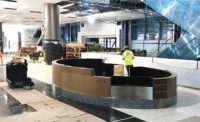The new normal at airports amid COVID-19 means getting smart about restroom construction and using design to make them as touchless as possible. Technologies already being tested at some major U.S. locations lend themselves to broader post-pandemic airport installation.
At the Dallas Fort-Worth airport (DFW), restrooms will be either rebuilt or retrofit, says Jonathan DeJesus, its senior customer programs manager for customer experience. “Touchless technologies are important to DFW Airport in both the current restroom designs and future restroom designs.”
DeJesus says the most important design change for a terminal restroom in the next 10 years will include “opportunities to replace fixtures/finishes, add additional capacity to meet demand, right-size restroom stalls/entries/square footage, and continuing to incorporate smart restroom technology with future enhancements.”
He did not have a date when DFW projects will go out to bid. The cost and design of the work varies depending on airport size and project scope, he says. “The effort is a huge undertaking as DFW has more than 130 restrooms, including more than 800 stalls and 560 sinks. We expect it will come to fruition over the next several years,” DeJesus says.
To make restroom facilities more resilient to germs amid the pandemic crisis, DFW wants “designs that will minimize customer interactions with high contact surface,” DeJesus adds. DFW terms its own smart-tech conversion “an evolving experience” as travelers want a clean, safe facility they can visit with confidence. The first phase of the conversion is expected to be completed in 2020.
“The touchless experience needs a design that shifts the focus from amenities to expanded and enhanced sanitation and safeguard processes,” DeJesus says.
Hartsfield-Jackson Atlanta International Airport was the first airport in the nation to construct smart restrooms when it partnered with Infax, a provider of innovative software solutions. Atlanta Airlines Terminal Co., the firm that manages airport facilities, spent $265,000 to go touchless earlier this year with additional touchless development happening in the next 10 years, a spokesperson said.
In June, Los Angeles World Airports and Tooshlights announced a pilot program of smart restrooms in one of the city airport terminals. The smart restroom pilot program of the Tooshlights system includes more than 20 smart restroom stalls, which will work similarly to parking garage lights. Each unit consists of a smart latch and indicator light. When the stall is available, the light is green. When the stall is occupied, and the smart latch activated, the light turns red. There are also blue indicator lights for ambulatory stalls.
Tooshlights will provide Infax with real-time venue-specific data that allows airport officials to track the occupancy usage of restroom stalls.
The American Restroom Association wants airport designs that include gender-neutral multi-stall toilet facilities with sinks in a common area, as well as hand sanitizer availability, says Executive Director Tim Pyle. “Airports can make modest gains with just small enhancements. Recently [Chicago] O’Hare updated some restrooms with very solid, new, full-height stalls with touchless soap, water and hand dryers at each sink," he says. "O’Hare was already ahead of the curve with its traditional floor-to-ceiling stall doors.".



Post a comment to this article
Report Abusive Comment